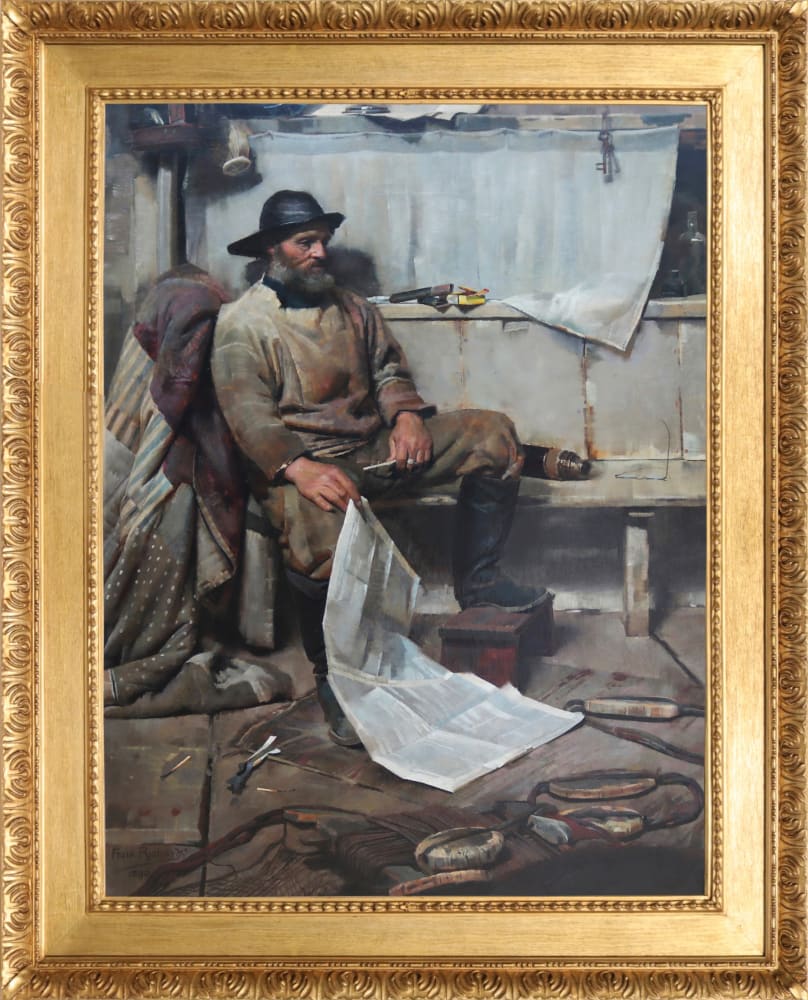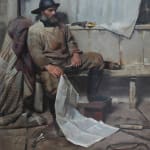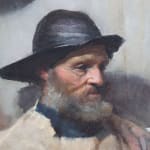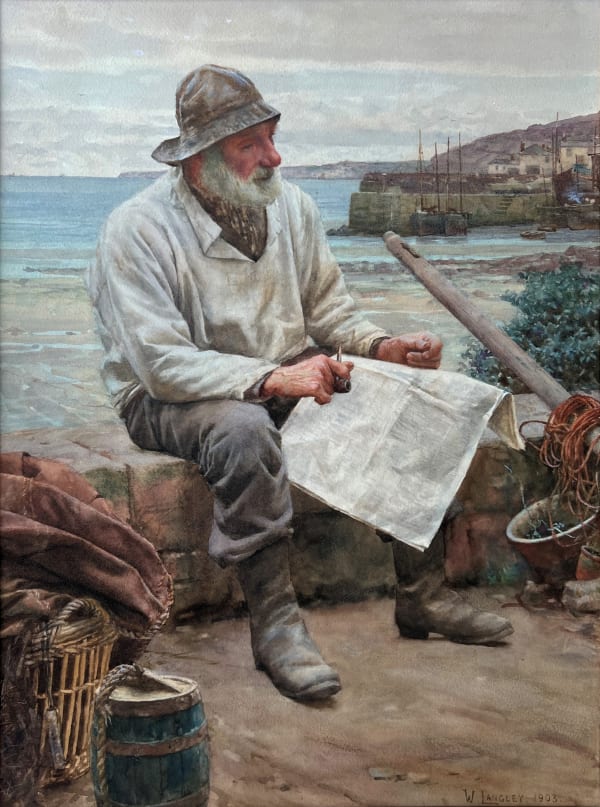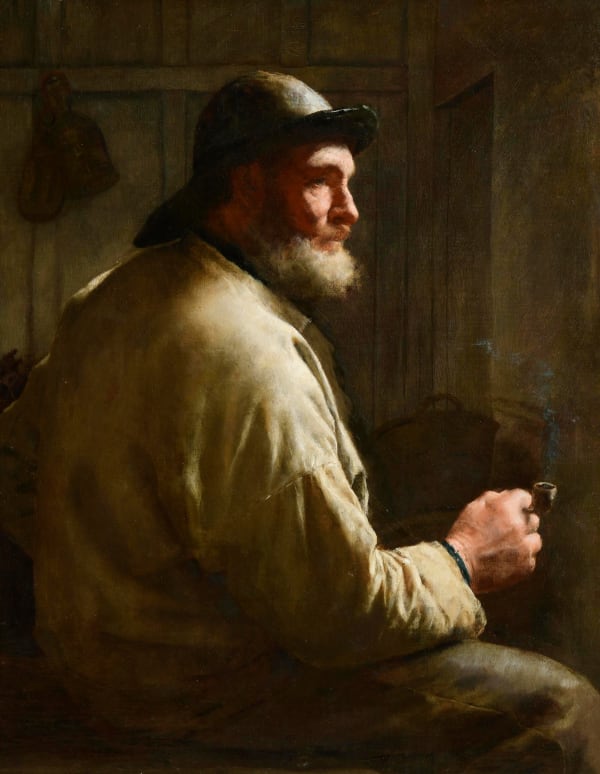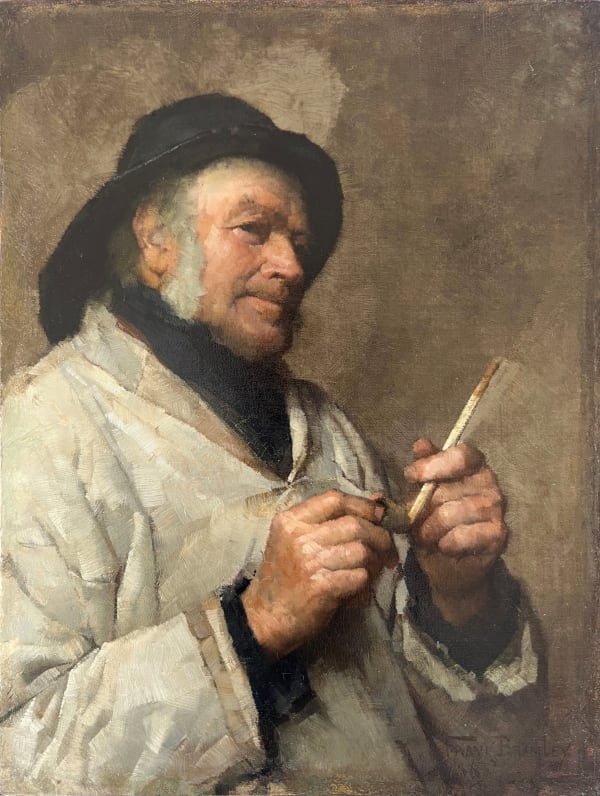
Fisherman Reading 1890, by Frank Richards

Fisherman Reading 1890 by Frank Richards, detail

Fisherman Reading on wall, Frank Richards
Frank Richards 1863-1935
Framed: 123.8 x 99.1 cm (48 3/4 x 39 ins)
Further images
Provenance
UK Private collection
Christies, New York, 22 Oct 2008 (Lot 259)
Exhibitions
Penlee House Gallery & Museum, 'Model Citizens: Myths and Realities'. 14 June - 6 Sept 2014
Penlee House Gallery & Museum, 'The Birmingham Boys'. 11 June - 10 Sept 2011
Penlee House Gallery & Museum, 'The Brotherhood of the Palette''. 20 June - 12 Sept 2009
Literature
Mary O’Neill, Cornwall’s Fisherfolk, Art & Artiface, Samson & Company. Pages 35 and 98.
Fisherman Reading is a significant Newlyn work completed in 1890, a year or so after Frank Richards joined his Birmingham compatriots and pioneers of the Newlyn School, Walter Langley and Edwin Harris. It’s a poignant example of the new realism and honesty that this school of artists were seeking to instil in British art by way of Newlyn and the lives of its fishing community.
As Mary O’Neill writes in Cornwall’s Fisherfolk, Art & Artiface; “Fisherman Reading features the familiar iconography of fishing gear … the newspaper, pipe, fiasco of Italian wine and the patchwork quilt all mark it visually as a ‘Newlyn’ painting. The fishing costume focuses attention on the face and hands of a working seaman. As a heroic masculine figure, Richard’s seaman is indeed toughened by ‘labour of many years’.”
O’Neill further elaborates upon the subject matter and its intended impact upon the contemporary audience “… newspapers were a means of linking an image to events of national interest. News of the Mount’s Bay fleet’s movements around the country’s coasts was also disseminated in this way. The fisherman’s demeanour and weary expression suggest the news, though unspecified, is bad. Yet his physical presence is designed to impress.”
Technically the painting is a highly accomplished square brush technique rendering with a palette that is typical of the works of Forbes and other leading Newlyn artists of the period. The work spent much of its life in the USA but was repatriated in 2008 and has since featured in a number of Penlee House Gallery & Museum public exhibitions including 'The Birmingham Boys', which celebrated the significance of the Birmingham artists in the establishment and legacy of the Newlyn School.
-
 Frank RichardsLizard LighthouseOil on canvas67.5 x 87.8 cm (26.6 x 34.6 ins.)
Frank RichardsLizard LighthouseOil on canvas67.5 x 87.8 cm (26.6 x 34.6 ins.)
Framed: 101.0 x 121.9 cm (39.8 x 48 ins.) -
 Frank RichardsEnd of the Day: Newlyn, 1891Oil on canvas30.6 cm x 40.7 cmSold
Frank RichardsEnd of the Day: Newlyn, 1891Oil on canvas30.6 cm x 40.7 cmSold -
 Walter LangleyThe News, Newlyn Harbour, 1903Watercolour and body colour on paper59.5 x 43.8 cm (23 1/2 x 17 1/4 ins)
Walter LangleyThe News, Newlyn Harbour, 1903Watercolour and body colour on paper59.5 x 43.8 cm (23 1/2 x 17 1/4 ins)
Framed: 82.5 x 66.7 cm (32 1/2 x 26 1/4 ins) -
 Edwin HarrisThe Fisherman's Rest, c. 1885Oil on canvas53.4 x 42 cm (21 x 16 1/2 ins.)Sold
Edwin HarrisThe Fisherman's Rest, c. 1885Oil on canvas53.4 x 42 cm (21 x 16 1/2 ins.)Sold
Framed: 72.3 x 61.0 cm (28 1/2 x 24 ins.) -
 Frank BramleyTamping his pipe, 1886Oil on canvas laid to board41.0 x 30.9 cm (16 1/8 x 12 3/16 ins.)Sold
Frank BramleyTamping his pipe, 1886Oil on canvas laid to board41.0 x 30.9 cm (16 1/8 x 12 3/16 ins.)Sold
Framed 59.5 x 51.8cm (23 1/2 x 20 1/2 ins.)


